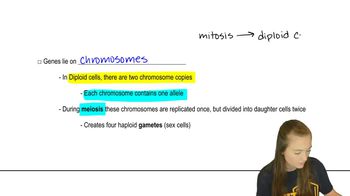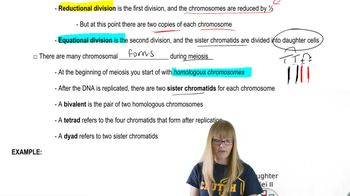Here are the essential concepts you must grasp in order to answer the question correctly.
Diploid and Haploid Cells
Diploid cells contain two complete sets of chromosomes, one from each parent, represented as 2n. In this case, the diploid cell has three pairs of homologous chromosomes. Haploid cells, on the other hand, have only one set of chromosomes (n), which is produced during meiosis. Understanding the difference between these cell types is crucial for analyzing the outcomes of mitosis and meiosis.
Recommended video:
Mitosis vs. Meiosis
Mitosis is a process of cell division that results in two genetically identical daughter cells, maintaining the diploid chromosome number. In contrast, meiosis is a specialized form of cell division that reduces the chromosome number by half, producing four genetically diverse haploid cells. Recognizing these processes is essential for determining the combinations of chromosomes in daughter cells and during meiotic stages.
Recommended video:
Homologous Chromosomes
Homologous chromosomes are pairs of chromosomes that have the same structure and gene sequence but may carry different alleles. In the context of the question, the pairs C1 and C2, M1 and M2, and S1 and S2 represent homologous chromosomes. Understanding how these pairs segregate during mitosis and meiosis is key to predicting the combinations of chromosomes in the resulting cells.
Recommended video:
 Verified step by step guidance
Verified step by step guidance Verified video answer for a similar problem:
Verified video answer for a similar problem:

